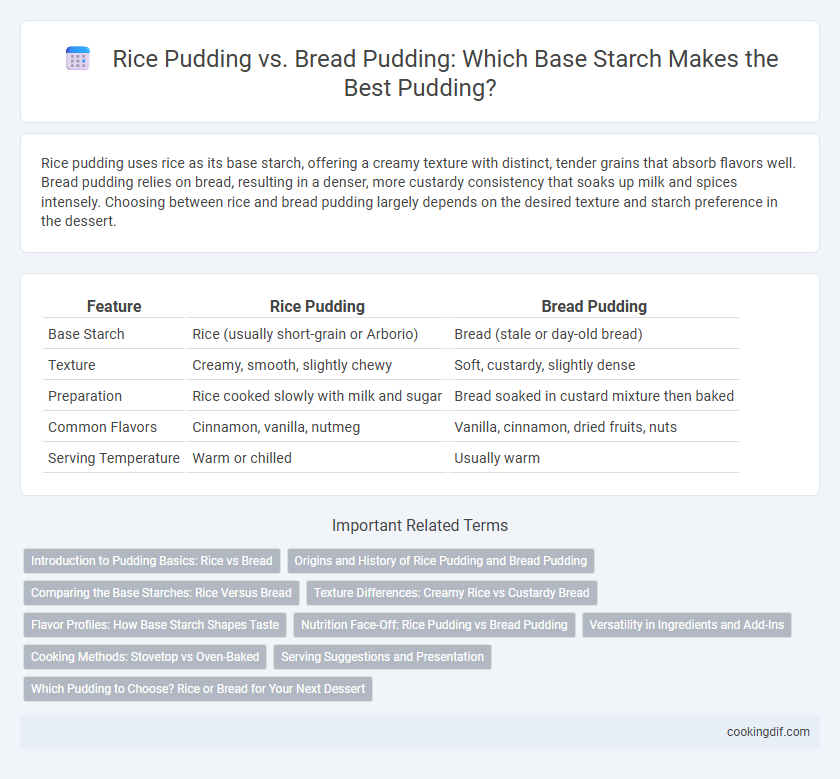Rice pudding uses rice as its base starch, offering a creamy texture with distinct, tender grains that absorb flavors well. Bread pudding relies on bread, resulting in a denser, more custardy consistency that soaks up milk and spices intensely. Choosing between rice and bread pudding largely depends on the desired texture and starch preference in the dessert.
Table of Comparison
| Feature | Rice Pudding | Bread Pudding |
|---|---|---|
| Base Starch | Rice (usually short-grain or Arborio) | Bread (stale or day-old bread) |
| Texture | Creamy, smooth, slightly chewy | Soft, custardy, slightly dense |
| Preparation | Rice cooked slowly with milk and sugar | Bread soaked in custard mixture then baked |
| Common Flavors | Cinnamon, vanilla, nutmeg | Vanilla, cinnamon, dried fruits, nuts |
| Serving Temperature | Warm or chilled | Usually warm |
Introduction to Pudding Basics: Rice vs Bread
Rice pudding and bread pudding serve as classic bases in dessert making, each offering distinct textures due to their starch sources. Rice pudding utilizes short or medium-grain rice, which absorbs milk or cream to create a creamy, smooth consistency enriched by starch gelatinization. In contrast, bread pudding relies on stale or fresh bread cubes soaked in custard, where the bread's structure softens yet maintains slight firmness, resulting in a denser, cakey texture highlighting the interaction between wheat starch and eggs.
Origins and History of Rice Pudding and Bread Pudding
Rice pudding traces its origins to ancient civilizations in Asia and the Middle East, where rice was a staple grain used in early sweet dishes flavored with milk and spices. Bread pudding, with roots in medieval Europe, emerged as a frugal dessert to repurpose stale bread combined with milk, eggs, and sweeteners. Both desserts reflect cultural adaptations of available starch bases, evolving from practical nourishment to beloved traditional treats worldwide.
Comparing the Base Starches: Rice Versus Bread
Rice pudding, made from soft-cooked rice grains, offers a creamy texture and naturally absorbs flavors, making it subtly sweet and smooth. Bread pudding relies on bread pieces that soak up custard, resulting in a denser, chewier consistency with a slightly crisp crust when baked. The choice between rice and bread as the base starch significantly influences the dish's texture, flavor absorption, and moisture retention.
Texture Differences: Creamy Rice vs Custardy Bread
Rice pudding features a smooth and creamy texture due to the gelatinization of starches in the rice grains, creating a rich mouthfeel that coats the palate. Bread pudding offers a custardy consistency where soaked bread absorbs the egg and milk mixture, producing a soft yet slightly spongy texture with a tender crumb. The starch source in rice pudding delivers a more uniform creaminess, while bread pudding presents varied textures from the soaked bread and caramelized edges.
Flavor Profiles: How Base Starch Shapes Taste
Rice pudding offers a creamy, subtly sweet base with a delicate texture that absorbs spices like cinnamon and nutmeg, enhancing its comforting flavor profile. Bread pudding uses dense, porous bread that soaks up custard, resulting in a richer, buttery taste with caramelized edges that add depth and complexity. The choice of base starch fundamentally influences the dessert's mouthfeel and flavor intensity, shaping the overall sensory experience.
Nutrition Face-Off: Rice Pudding vs Bread Pudding
Rice pudding typically contains fewer calories and less fat compared to bread pudding, making it a lighter dessert option with a smoother texture from the rice starch. Bread pudding, made from bread as its base starch, generally has higher fiber content and more complex carbohydrates, contributing to longer satiety and richer nutritional benefits. Both desserts offer unique nutritional profiles, with rice pudding providing more easily digestible carbs and bread pudding delivering increased protein and micronutrients depending on the bread type used.
Versatility in Ingredients and Add-Ins
Rice pudding's base starch provides a creamy, neutral canvas that pairs well with fruits, nuts, and spices, allowing for diverse flavor profiles. Bread pudding's bread base absorbs custard thoroughly, making it ideal for rich add-ins like chocolate, caramel, and dried fruits. Both puddings offer versatile ingredient combinations, with rice pudding excelling in smooth textures and bread pudding favored for chunkier, hearty variations.
Cooking Methods: Stovetop vs Oven-Baked
Rice pudding typically uses stovetop cooking, allowing precise control over heat to slowly thicken the mixture and infuse flavors, resulting in a creamy texture. Bread pudding is usually oven-baked, which creates a custardy center with a slightly crisp, golden-brown crust by evenly distributing heat throughout the baking process. The stovetop method emphasizes continuous stirring to prevent scorching, while oven-baking leverages dry heat to set the pudding with a firm yet tender structure.
Serving Suggestions and Presentation
Rice pudding offers a creamy texture that pairs beautifully with fresh fruit toppings such as mango or berries, making it ideal for elegant individual servings in small bowls or glass jars. Bread pudding, with its dense and custardy base, complements warm spices like cinnamon and nutmeg, often presented in rustic ceramic dishes or ramekins, garnished with a drizzle of caramel or a dusting of powdered sugar. Both desserts benefit from a final touch of whipped cream or a scoop of vanilla ice cream to enhance flavor and visual appeal.
Which Pudding to Choose? Rice or Bread for Your Next Dessert
Rice pudding offers a creamy texture with a naturally sweet and slightly chewy base, ideal for those seeking a comforting, gluten-free dessert rich in carbohydrates and subtle flavors. Bread pudding provides a denser, custard-soaked foundation that absorbs spices and additions effectively, making it a versatile choice with a hearty, satisfying bite. Choosing between rice and bread pudding depends on dietary preferences, desired texture, and flavor profile, with rice pudding leaning towards silky smoothness and bread pudding delivering a rich, spongy experience.
Rice pudding vs bread pudding for base starch Infographic

 cookingdif.com
cookingdif.com